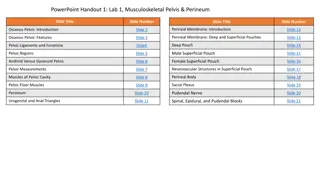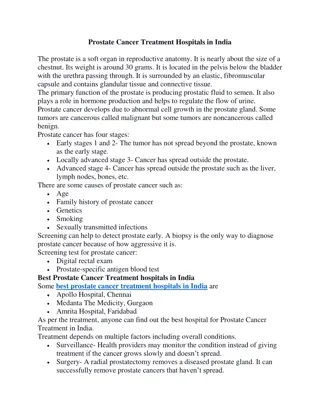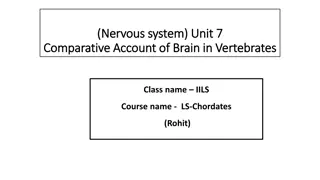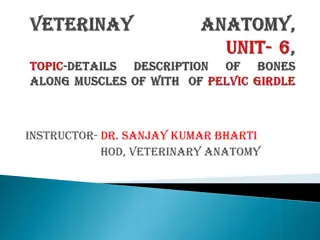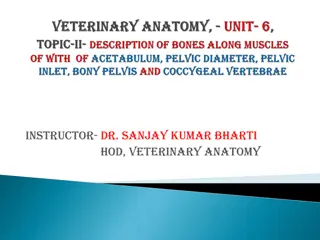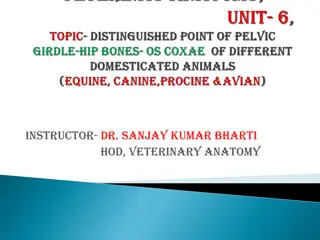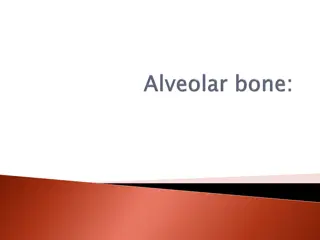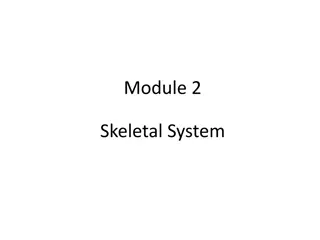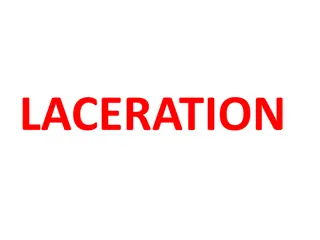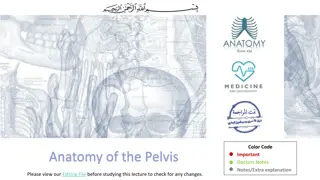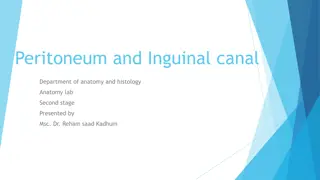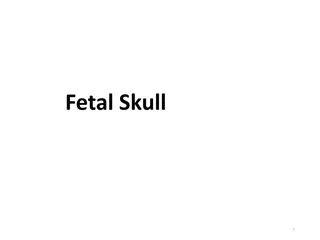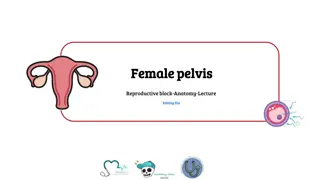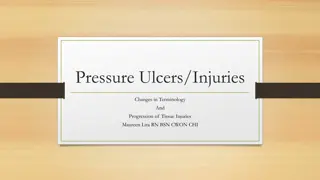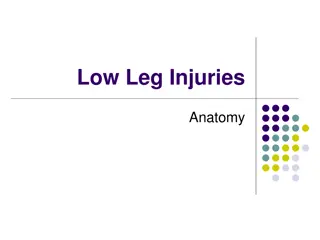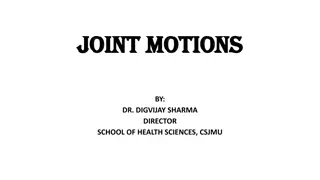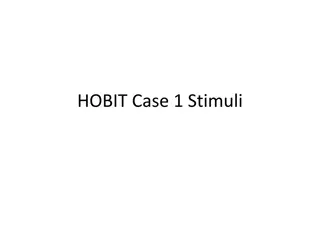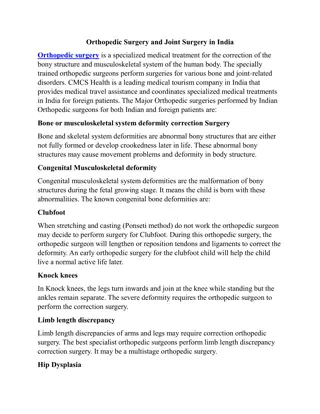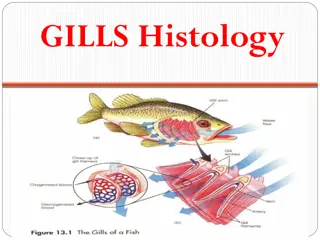Musculoskeletal Pelvis & Perineum Overview
Explore the anatomy of the pelvis and perineum, including the osseous pelvis structure, features, ligaments, and pelvic regions. Learn about the division of the abdominopelvic cavity and key neurovascular structures in this comprehensive PowerPoint presentation.
2 views • 21 slides
Understanding the Fascinating World of Fishes: A Comprehensive Overview
Fishes, the most numerous vertebrates on Earth, exhibit incredible diversity across various groups such as Agnatha, Chondrichthyes, and Osteichthyes. From jawless Agnatha like lampreys to bony Osteichthyes including lobe-finned and ray-finned species, fishes display unique characteristics and adapta
6 views • 8 slides
Pediatric Trauma Resources: Chest, Abdomen, and Pelvis Review
This guideline provides resources for the evaluation and management of chest, abdomen, and pelvic trauma in pediatric patients. It covers a range of topics including thoracic injuries, abdominal trauma evaluation, nonoperative management protocols, and guidelines for various pediatric injuries. The
4 views • 21 slides
Best Prostate Cancer Treatment Hospitals in India
The prostate is a soft organ in reproductive anatomy. It is nearly about the size of a chestnut. Its weight is around 30 grams. It is located in the pelvis below the bladder with the urethra passing through. It is surrounded by an elastic, fibromuscular capsule and contains glandular tissue and conn
1 views • 2 slides
Animal Muscle Identification and Anatomy Diagrams
This collection includes detailed diagrams showcasing the identification and anatomy of muscles in animals, specifically focusing on pig muscle anatomy. From head and neck muscles to arm and shoulder muscles, pelvis and thigh muscles, and trunk muscles, these visual aids help understand the structur
2 views • 26 slides
Anatomy of the Pharyngo-Tympanic Tube (Eustachian Tube) Explained
The pharyngo-tympanic tube, also known as the Eustachian tube or auditory tube, is a vital structure connecting the nasopharynx with the tympanic cavity. It plays a crucial role in maintaining air pressure equilibrium on both sides of the tympanic membrane. Comprising bony and cartilaginous parts, i
0 views • 14 slides
Comparative Analysis of Vertebrate Brains: From Cartilaginous Fish to Amphibians
The brain in vertebrates varies in size and complexity, with distinct structures like the prosencephalon and mesencephalon. From cartilaginous fishes with large olfactory lobes to bony fishes with specialized brains, the evolution of brain structures can be observed. Amphibians, like frogs, show uni
1 views • 12 slides
Understanding Pelvic Limb Anatomy: Bones and Muscles Overview
Bones and muscles of the pelvic limb, including the pelvis, thigh, leg, and foot, are detailed in this informative content. It covers the general designations of pelvic bones, descriptions of bones along with muscle attachments in various animals, and specifics about the hip bone structure and forma
1 views • 15 slides
Veterinary Anatomy Overview: Pelvic Cavity and Bony Pelvis Structures
The instructor, Dr. Sanjay Kumar Bharti, explains the acetabulum, obturator foramen, sexual differences, and characteristics of sheep and goats related to pelvic anatomy. Details include the structure of the acetabulum, the large obturator foramen, pelvic cavity, and differences between male and fem
2 views • 18 slides
Anatomy of the Upper Limb: Clavicle, Scapula, Humerus
The upper limb anatomy includes detailed descriptions of the clavicle, scapula, and humerus bones. The clavicle is a long bone that articulates with the sternum and scapula, while the scapula lies on the posterior chest wall and has important bony landmarks like the acromion and glenoid cavity. The
2 views • 15 slides
Veterinary Anatomy: Pelvic Structures and Sexual Dimorphism in Animals
The article discusses the anatomy of the acetabulum, obturator foramen, pelvic cavity, pelvic inlet and outlet, and sexual differences in the pelvis, with a focus on sheep and goats. It covers the structure of these pelvic components and highlights the variations between male and female anatomies. D
0 views • 19 slides
Understanding the Role of Alveolar Process in Dental Support
The alveolar process in the upper and lower jaw plays a crucial role in supporting teeth, anchoring them to the alveoli with Sharpey's fibers. It helps in tooth movement for proper occlusion, absorbs and distributes occlusal forces, supplies vessels to the periodontal ligament, and protects both pri
2 views • 42 slides
Comprehensive Guide to the Skeletal System
Explore the fascinating world of the skeletal system, including types of bone, bone formation processes, fractures healing, axial and appendicular skeleton, joints classification, and detailed insights into various types of joints. Dive into the anatomy of the pelvis, paranasal sinuses, and the shou
0 views • 20 slides
Understanding Lacerations: Causes and Types
Lacerations are tears or splits in the skin, mucous membranes, muscles, or internal organs caused by blunt force application. This article explores different types of lacerations such as split lacerations, stretch lacerations, and avulsion lacerations. Additionally, it delves into the impact of blun
0 views • 55 slides
Sex Determination Through Bone Analysis in Forensic Anthropology
In forensic anthropology, the pelvis and skull are crucial in sex determination, with additional assistance from femur, tibia, and humerus measurements. This data sheet guides on circling male or female based on traits like sub-pubic angle, pelvic cavity shape, eye orbit sharpness, zygomatic process
0 views • 33 slides
Fascinating Facts About Seahorses
Seahorses, though fish, have unique characteristics such as swimming upright, bony plates instead of scales, and the male carrying and birthing the babies. They inhabit warm coastal seas worldwide, with some species found in specific regions like Australia. Seahorses feed on small marine creatures l
0 views • 8 slides
Understanding Joint Motion: Osteokinematic and Arthrokinematic Movements
Joint motion involves osteokinematic movements, which are under voluntary control and include flexion, extension, and more. End-feel sensations like bony, capsular, and springy block indicate different joint conditions. Arthrokinematic motion refers to how joint surfaces move during osteokinematic m
0 views • 17 slides
Understanding Flexibility and Stretching Techniques
Flexibility is crucial for optimal physical performance and injury prevention. It refers to the ability to move joints through a full range of motion without restrictions. Factors limiting flexibility include tissue elasticity, bony structure, and muscle/tendon extensibility. Understanding active an
0 views • 28 slides
Understanding Juvenile Hallux Valgus: Diagnosis and Management Insights
Delve into the world of juvenile hallux valgus, a condition affecting the alignment of the big toe in children. Learn about its different forms based on age groups, associated anatomical features, pathoanatomy, soft tissue, and bony deformities. Discover the hereditary and syndromic links, diagnosti
0 views • 45 slides
Understanding Pelvic Anatomy: Bones, Joints, and Muscles
Explore the comprehensive overview of the anatomy of the pelvis, including its walls, bones, joints, muscles, and differentiations between male and female pelves. Learn about the boundaries, subdivisions, and pelvic floor components, as well as the arterial, nerve, lymph, and venous supplies. Delve
0 views • 27 slides
Understanding Occipito-Posterior Position of the Fetal Head
Occipito-posterior position refers to the fetal head being directed towards the back of the pelvis. This positioning can occur to the right (ROP) or left (LOP) side. It occurs in 13% of vertex presentations and may be caused by factors like pendulous abdomen, pelvic brim shape, or sacral alignment.
0 views • 31 slides
Understanding Peritoneum and Inguinal Canal in Anatomy
Peritoneum is a thin serous membrane covering the abdomen and pelvis, consisting of parietal and visceral layers with a peritoneal cavity between them. Learn about peritoneal relations, intraperitoneal versus retroperitoneal organs, and folds of peritoneum like ligaments and omenta in this detailed
0 views • 21 slides
Understanding the Anatomy of the Fetal Skull
The fetal skull is a bony cavity that protects the delicate brain and plays a crucial role in the birthing process. This detailed guide explores the composition of the fetal skull, including the bones, sutures, fontanels, regions, and landmarks. Understanding these aspects is essential for assessing
0 views • 18 slides
Understanding Female Pelvis Anatomy and Differences from Male Pelvis
The female pelvis anatomy lecture covers the pelvic wall, bones, joints, and muscles. It explains the boundaries, subdivisions, and types of female pelvis, along with details on pelvic walls, floor, and diaphragm components. Additionally, it includes information on arterial, nerve, lymph, and venous
0 views • 13 slides
Understanding Pressure Ulcers and Tissue Injuries Progression
Pressure ulcers, also known as pressure injuries, are localized damages to the skin and underlying soft tissue usually over bony prominences. The National Pressure Ulcer Advisory Panel changed the terminology in 2016 to classify all stages as injuries, not just ulcers. Stages range from non-blanchab
0 views • 13 slides
Understanding the Orbital Region: An Overview
The orbital region encompasses the orbits, eyelids, ciliary and tarsal glands, and anatomical borders. It consists of bony cavities protecting the eyeballs, eyelids that shield the eyes, and intricate structures like the lacrimal apparatus and muscles. Understanding the components and anatomical rel
0 views • 15 slides
Effectiveness of Peanut Birthing Ball in Laboring Mothers with Epidural
The use of a peanut birthing ball during labor for mothers with epidurals aims to reduce the duration of the first stage of labor and decrease the incidence of primary cesarean sections. Evidence suggests that peanut balls help open the maternal pelvis, aiding in fetal rotation and descent. This int
0 views • 10 slides
Understanding Low Leg Injuries and Anatomy
Explore the anatomy of the lower leg, focusing on common injuries like shin splints. Learn about muscles, bones, and bony landmarks involved in conditions such as medial tibial stress syndrome. Discover the causes, symptoms, and treatments for these issues.
0 views • 10 slides
Understanding Joint Motions and Osteokinematics in Human Anatomy
Joint motions involve rolling, sliding, and spinning of joint surfaces, with one surface serving as the fixed base for motion. Arthrokinematics explains the movement of joint surfaces, while osteokinematics focuses on bone movements within anatomical range of motion. The types of joint motions depen
0 views • 9 slides
Diagnostic Workup Results for Patient X
The diagnostic workup for Patient X includes various imaging studies such as ECG, CXR, Head CT scan, CT Abdomen/Pelvis, and Repeat CXR. Laboratory results show abnormal CBC values, BMP findings, LFTs, and lactate levels with associated VBG results. Further evaluation is needed based on these results
0 views • 11 slides
Orthopedic surgery in India
Orthopedic surgery is a specialized medical treatment for the correction of the bony structure and musculoskeletal system of the human body. The specially trained orthopedic surgeons perform surgeries for various bone and joint-related disorders. CMC
1 views • 4 slides
Understanding Teleost Gill Histology and Function
This presentation delves into the intricate histology of teleost gills, showcasing the structure of primary and secondary lamellae, epithelial cells, mucous cells, and more. It illustrates the branchial anatomy in bony fish, detailing the arrangement of holobranchs and hemibranchs. Additionally, it
0 views • 11 slides
